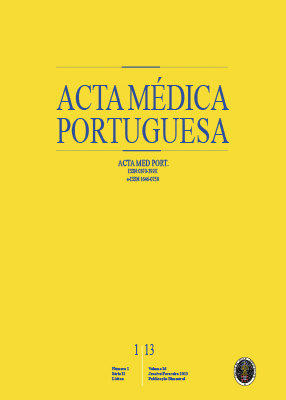Osteogenesis Imperfecta – Experience of Dona Estefânia’s Hospital Orthopedics’ Department
DOI:
https://doi.org/10.20344/amp.4005Abstract
Introduction/Aims: Osteogenesis imperfecta (OI) is a genetic disorder characterized by bone fragility and osteopenia. Treatment involves a multidisciplinary approach and aims to improve the quality of life. The authors aimed to describe the characteristics of a sample of children with OI, to evaluate the treatment and clinical outcome before and after therapy. Material and Methods: An observational, longitudinal, retrospective and analytic study based on data obtained from the analisys of the clinical files of all patients with OI included in the pamidronate treatment protocol in Dona Estefânia’s Hospital. The studied variables were: gender, age at diagnosis, familiar history of OI, age at fracture, fracture location, number of fractures, medical/surgical therapy, age at onset of treatment, number of courses of medical therapy, age at surgical treatment and its complications. A five percent statistics significance level was adopted. Results: in 21 patients, 61.9% were male and 11 had its OI type registered (five type I, three type III, three type IV). The average age of diagnosis was 20.6 months and there were two diagnostic peaks: the first month - 37%, and 24 months - 26%. On average patients had 0.62 fractures/patient/year, of which 17.4% in the perinatal period and 62% before age three. Most of the fractures occurred in the lower limbs (55.6%). All patients underwent medical treatment, starting at an average of 4.3 years. In follow-up sample (n=14) there was a decrease in the number of fractures after starting treatment with pamidronate (0.76 to 0.35 fractures/patient/year). Intramedullary rods were placed in nine patients (64.3%). In eight patients they were placed in the femur, four unilateral and four bilateral, with no prior history of fracture in three cases. There were no new fractures in the surgically treated bones. Conclusion: OI is a disease with a wide clinical variability that mainly depends on its type. Despite no cure has been found, medical treatment with biphosphonates and surgical treatment, with intramedullary rods, seems to reduce the incidence of new fracture occurrence.
Downloads
Downloads
Published
How to Cite
Issue
Section
License
All the articles published in the AMP are open access and comply with the requirements of funding agencies or academic institutions. The AMP is governed by the terms of the Creative Commons ‘Attribution – Non-Commercial Use - (CC-BY-NC)’ license, regarding the use by third parties.
It is the author’s responsibility to obtain approval for the reproduction of figures, tables, etc. from other publications.
Upon acceptance of an article for publication, the authors will be asked to complete the ICMJE “Copyright Liability and Copyright Sharing Statement “(http://www.actamedicaportuguesa.com/info/AMP-NormasPublicacao.pdf) and the “Declaration of Potential Conflicts of Interest” (http:// www.icmje.org/conflicts-of-interest). An e-mail will be sent to the corresponding author to acknowledge receipt of the manuscript.
After publication, the authors are authorised to make their articles available in repositories of their institutions of origin, as long as they always mention where they were published and according to the Creative Commons license.









